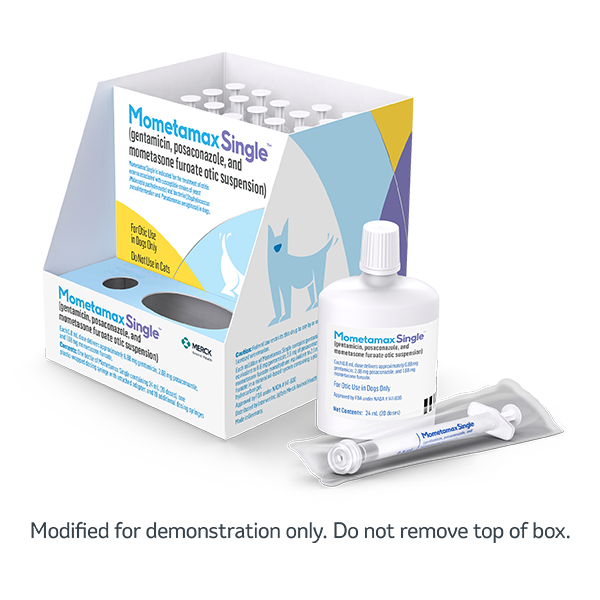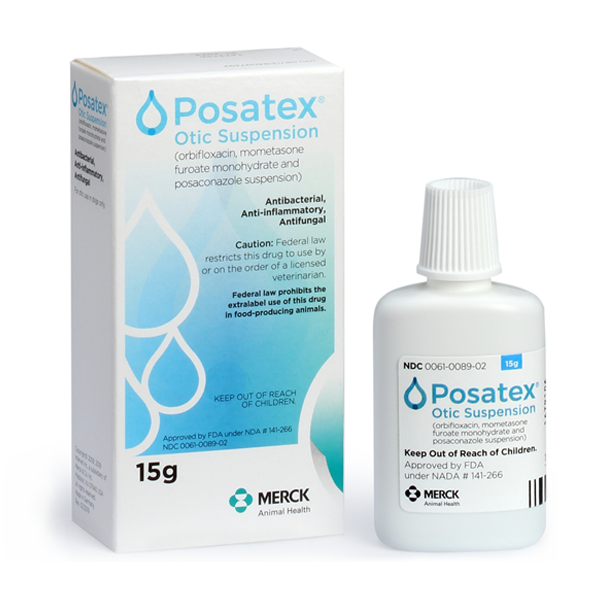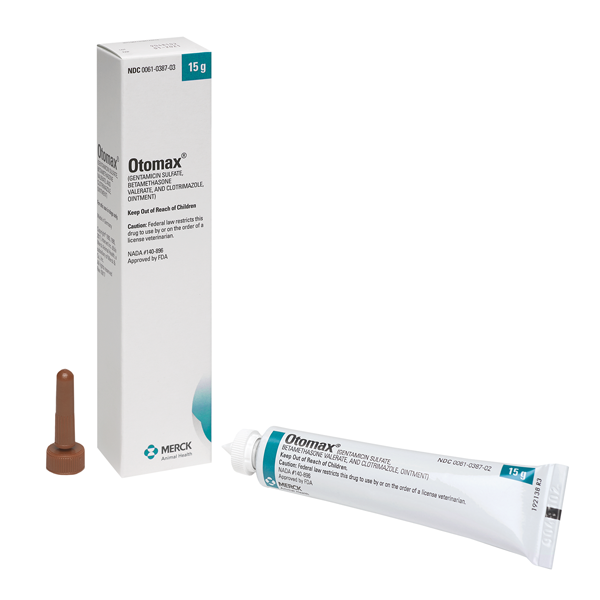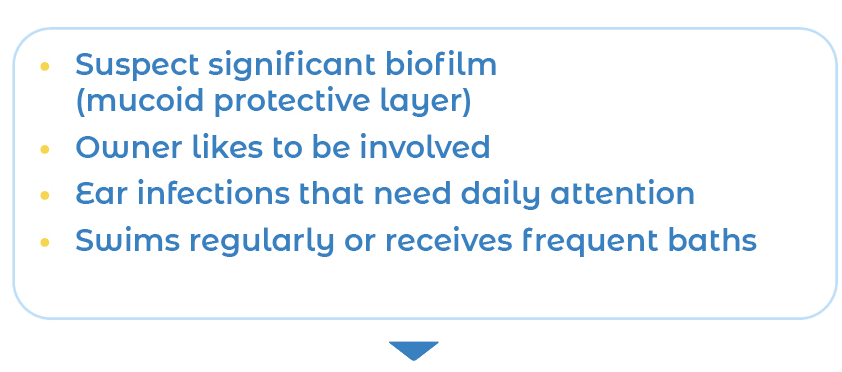
What to Know About Otitis Externa
Otitis externa is a common ear condition that can be quite painful for dogs. The condition can recur if not treated properly.
What Is Otitis Externa?
Otitis externa is a common ear condition involving inflammation of the external ear canal. The condition often appears to develop suddenly and can be quite painful for dogs. If your patient has otitis externa, either one or both ears may be affected to a varying extent.1,2
How can you tell if a dog may have otitis externa?
Common signs to watch for include:
- Rubbing or scratching of the ears
- Head shaking
- Pain or discomfort
- An unpleasant odor or discharge from the ears
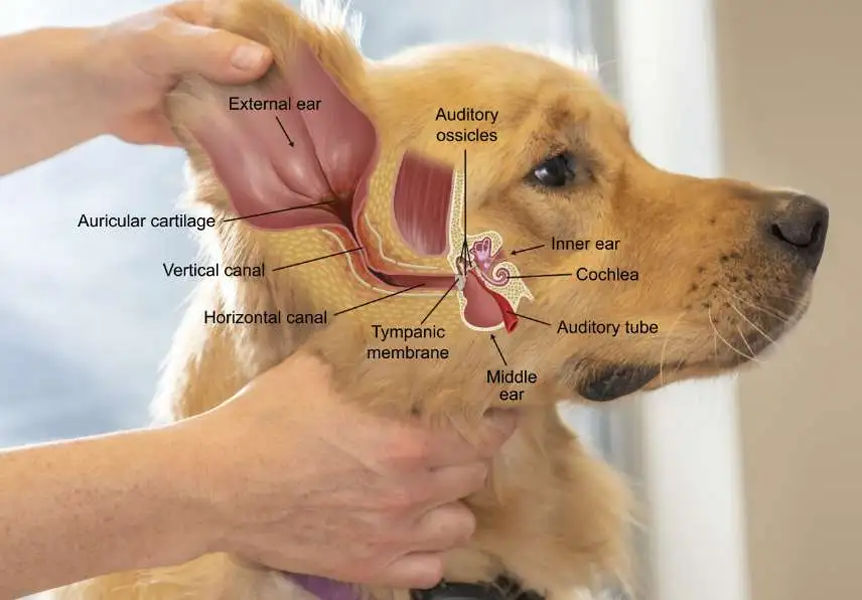

Otitis externa affects up to
seen in veterinary practice3,4
How Common Is Otitis Externa?
Otitis externa is very common. Up to 1 in 7 dogs seen in veterinary practice will get otitis externa at some point in their lives.3,4 Otitis externa can also recur—1 in 4 dogs with otitis externa will get it again at least once.3
There are many reasons why dogs may have otitis externa.
The most common cause is allergies to something in the environment or, less often, to food.5,6
Other causes include7:
- Parasites
- Foreign bodies in ear canal
- Skin disorders
- Other diseases
- Activities like swimming that introduce water into ears
Some breeds, particularly dogs with long or floppy ears, appear to be more likely to develop otitis externa.
How Should Pet Owners Care for Their Dog’s Ears?
It is important to identify any underlying factors that led to the dog’s condition and treat them properly. Without identifying the underlying cause, treatment may provide only temporary relief, and the dog’s otitis externa could recur.
After a dog has been treated for otitis externa, the owner should start seeing signs that the dog’s ear condition is improving, such as less redness, scratching, pain, or discharge. Be sure to recommend a follow-up appointment to check how the dog is doing.
The best way to prevent a dog from getting otitis externa again is to encourage owners to maintain the dog’s ear and skin health.
Recommend dog’s ears are cleaned at appropriate intervals, and ensure owners know how to dry them thoroughly after a bath or swimming. Encourage owners to treat any underlying conditions like allergic dermatitis.

Deliver the Right Treatment for Every Unique Case


Discover the benefits of the newest single-dose, in-clinic otic treatment.
Important Safety Information
MOMETAMAX SINGLE: Mometamax Single is for otic use in dogs only. Do not use in cats. Mometamax Single should be administered by veterinary personnel. Do not use in dogs with known tympanic membrane perforation. The integrity of the tympanic membrane should be confirmed before administering the product. Reevaluate the dog if hearing loss or signs of vestibular dysfunction are observed during treatment. Do not use in dogs with known or suspected hypersensitivity to gentamicin, posaconazole, or mometasone furoate. Avoid contact with eyes. For complete instructions and safety information, refer to the product label.
MOMETAMAX: Do not use MOMETAMAX Otic Suspension in pregnant dogs. The use of these components has been associated with deafness or partial hearing loss in a small number of sensitive dogs (e.g., geriatric), although it is usually temporary. If hearing or vestibular dysfunction is noted, discontinue use immediately and flush the ear canal thoroughly with a non-ototoxic solution. If hypersensitivity to any of the components occurs, treatment should be discontinued and appropriate therapy instituted. Concomitant use of drugs known to induce ototoxicity should be avoided. Do not use in dogs with known tympanic perforation. Administration of recommended doses beyond 7 days may result in delayed wound healing. Avoid ingestion. Keep out of the reach of children. For complete safety information, refer to the product label.
POSATEX: POSATEX Otic Suspension is contraindicated in dogs with known or suspected hypersensitivity to quinolones, mometasone furoate monohydrate, or posaconazole. Do not administer orally. Immediately discontinue use if hearing loss is observed during treatment. Do not use in dogs with known tympanic perforation. Avoid prolonged or repeated use of POSATEX Otic Suspension. Long-term use of topical otic corticosteroids has been associated with adrenocortical suppression and iatrogenic hyperadrenocorticism in dogs. The safe use in dogs used for breeding purposes, during pregnancy, or in lactating bitches has not been evaluated. Not for use in humans. Keep out of reach of children. For complete safety information, refer to the product label.
OTOMAX: Do not use in dogs with known perforation of eardrums. The use of OTOMAX ointment has been associated with deafness or partial hearing loss in a small number of sensitive dogs (e.g., geriatric), though this is usually temporary. If hypersensitivity occurs, treatment should be discontinued. Concomitant use of drugs known to induce ototoxicity should be avoided. Administration of recommended doses beyond 7 days may result in delayed wound healing. Avoid ingestion. Keep out of the reach of children. For complete safety information, refer to the product label.
References:
1. Kasai T, Fukui Y, Aoki K, et al. J Appl Microbiol. 2020;130:1084-1091. 2. Borriello G, Paradiso R, Catozzi C, et al. PLoS One. 2020;15:e0241447. 3. Perry LR, MacLennan B, Korven R, et al. Can Vet J. 2017;58:168-174. 4. O’Neill DG, Church DB, McGreevy PD, et al. PLoS One. 2014;9:e90501. 5. Hnilica KA. In: Small Animal Dermatology: A Color Atlas and Therapeutic Guide. 4th ed. Elsevier; 2017:416-430. 6. Zur G, Lifshitz B, Bdolah-Abram T. J Small Anim Pract. 2011;52:254-258. 7. Nuttall T. Managing recurrent otitis externa in dogs: what have we learned and what can we do better? J Am Vet Med Assoc. 2023:261(S1): S10-S22. doi:10.2460/javma.23.01.0002

